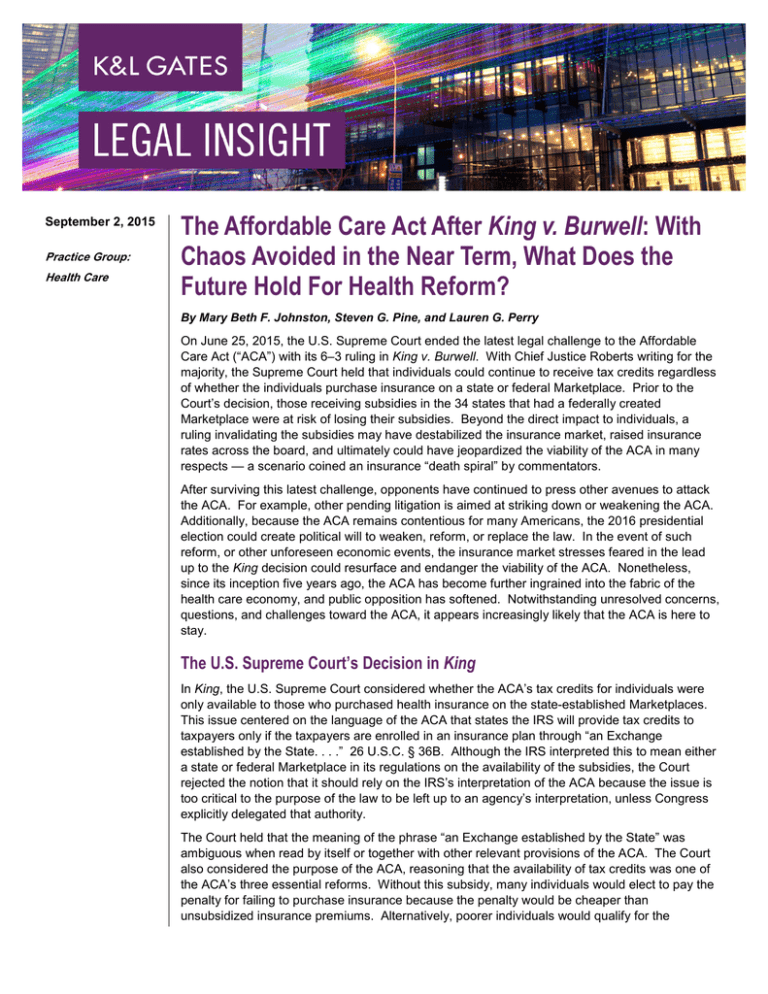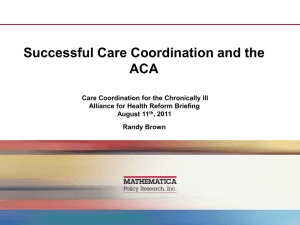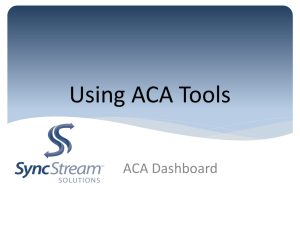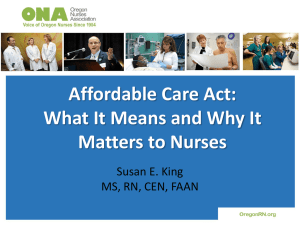
September 2, 2015
Practice Group:
Health Care
The Affordable Care Act After King v. Burwell: With
Chaos Avoided in the Near Term, What Does the
Future Hold For Health Reform?
By Mary Beth F. Johnston, Steven G. Pine, and Lauren G. Perry
On June 25, 2015, the U.S. Supreme Court ended the latest legal challenge to the Affordable
Care Act (“ACA”) with its 6–3 ruling in King v. Burwell. With Chief Justice Roberts writing for the
majority, the Supreme Court held that individuals could continue to receive tax credits regardless
of whether the individuals purchase insurance on a state or federal Marketplace. Prior to the
Court’s decision, those receiving subsidies in the 34 states that had a federally created
Marketplace were at risk of losing their subsidies. Beyond the direct impact to individuals, a
ruling invalidating the subsidies may have destabilized the insurance market, raised insurance
rates across the board, and ultimately could have jeopardized the viability of the ACA in many
respects — a scenario coined an insurance “death spiral” by commentators.
After surviving this latest challenge, opponents have continued to press other avenues to attack
the ACA. For example, other pending litigation is aimed at striking down or weakening the ACA.
Additionally, because the ACA remains contentious for many Americans, the 2016 presidential
election could create political will to weaken, reform, or replace the law. In the event of such
reform, or other unforeseen economic events, the insurance market stresses feared in the lead
up to the King decision could resurface and endanger the viability of the ACA. Nonetheless,
since its inception five years ago, the ACA has become further ingrained into the fabric of the
health care economy, and public opposition has softened. Notwithstanding unresolved concerns,
questions, and challenges toward the ACA, it appears increasingly likely that the ACA is here to
stay.
The U.S. Supreme Court’s Decision in King
In King, the U.S. Supreme Court considered whether the ACA’s tax credits for individuals were
only available to those who purchased health insurance on the state-established Marketplaces.
This issue centered on the language of the ACA that states the IRS will provide tax credits to
taxpayers only if the taxpayers are enrolled in an insurance plan through “an Exchange
established by the State. . . .” 26 U.S.C. § 36B. Although the IRS interpreted this to mean either
a state or federal Marketplace in its regulations on the availability of the subsidies, the Court
rejected the notion that it should rely on the IRS’s interpretation of the ACA because the issue is
too critical to the purpose of the law to be left up to an agency’s interpretation, unless Congress
explicitly delegated that authority.
The Court held that the meaning of the phrase “an Exchange established by the State” was
ambiguous when read by itself or together with other relevant provisions of the ACA. The Court
also considered the purpose of the ACA, reasoning that the availability of tax credits was one of
the ACA’s three essential reforms. Without this subsidy, many individuals would elect to pay the
penalty for failing to purchase insurance because the penalty would be cheaper than
unsubsidized insurance premiums. Alternatively, poorer individuals would qualify for the
The Affordable Care Act After King v. Burwell: With Chaos Avoided in the Near
Term, What Does the Future Hold For Health Reform?
exception from the individual mandate because without the tax credit, the cost of insurance would
exceed 8 percent of some individuals’ income.
Given the context and purpose of the ACA, the Court concluded that Congress must have
intended to make the tax credits available to individuals purchasing insurance on both the
federally established and state-established Marketplaces. The Court found that Congress
intended for the tax credits to be available to those who obtained health insurance on the federal
Marketplaces. To interpret otherwise would mean that the entire individual insurance market
could be destabilized, which would defeat the purpose of the ACA itself — to have more
Americans enrolled in health insurance and to have a vibrant insurance marketplace.
Continued Litigation Against the ACA
The ACA continues to confront litigation within the courtroom aimed at scaling back the law. One
such case is House v. Burwell, where the U.S. House of Representatives claims that the Obama
administration has acted illegally in its implementation of the ACA. More specifically, the House
claims that the Administration exceeded its authority by spending funds without Congress’
permission when it implemented the “cost-sharing reductions” of the ACA. The “cost-sharing
reductions” involve the government paying a subsidy directly to the insurer in exchange for
reducing deductibles, coinsurance, and copayments to lower-income enrollees. If the D.C. Circuit
finds that the Obama administration exceeded its authority and invalidates the subsidies, the
largest effect will be felt by those enrollees who benefit from these cost-sharing reduction
payments, which is more than half of all the enrollees who purchased an insurance plan through
the Marketplace. Currently a motion to dismiss the challenge is pending in the D.C. Circuit of the
U.S. District Court.
Other litigation challenges to the ACA claim that the ACA violated the Origination Clause of the
U.S. Constitution. The Origination Clause requires all bills that raise revenues to originate from
the House of Representatives. The plaintiffs in the two lawsuits claim that the individual mandate
is a revenue-raising bill, which did not originate from the House of Representatives. In Sissel v.
HHS, the D.C. Circuit held that the bill was not one that “raised revenue” and dismissed the
complaint. The plaintiffs attempted to revive the claim by petitioning for a rehearing en banc;
however, that petition was recently denied by the D.C. Circuit as well. The Fifth Circuit case,
Hotze v. Burwell, does not seem exceptionally threatening to the ACA, either. In Hotze, the
plaintiffs raised the same claim, but the Fifth Circuit held that the plaintiffs did not have standing
for lack of injury caused by the individual mandate. The plaintiffs have also filed a petition to have
the hearing en banc, but the Fifth Circuit has yet to rule on whether it would rehear the matter.
While the Origination Clause cases received media coverage as a major challenge to the ACA, it
seems unlikely that the cases will make their way to the U.S. Supreme Court. Perhaps the
largest threat comes from the upcoming presidential election.
Economic and Political Threats Continue Against the ACA
Many Americans are still fiercely opposed to the ACA. As data begins to show real benefits are
inuring to both patients and providers through an increase in coverage and a reduction in
uncompensated care, public opinion of the ACA has slowly improved. However, others have
deep-rooted philosophical or political disagreements about the scope of the law or how it was
enacted. In other cases, opposition is tied to a belief that health care reform will be too costly in
the long run compared to the benefits it provides. The disagreements also extend to the decision
of whether or not to expand Medicaid coverage. For some, there is a concern that the
2
The Affordable Care Act After King v. Burwell: With Chaos Avoided in the Near
Term, What Does the Future Hold For Health Reform?
government will not hold up its end of the bargain to cover 90 percent of the costs of expansion.
For others, a fundamental opposition to the bill in its entirety extends to the Medicaid expansion
decision, irrespective of what potential benefits may be available with expansion.
This opposition may predictably come to a head in 2016 presidential election. With the
uncertainty associated with a change in administration, it is difficult to rule out the potential of an
outright repeal of the law. However, as more individuals sign up and qualify for insurance
subsidies, complete repeal may not have the political support it once held. Furthermore, full
repeal would still require 60 votes in the Senate to overcome a filibuster, which would likely be
difficult to achieve (although certain spending and tax provisions of the ACA could be eliminated
through the reconciliation process, only requiring 51 votes in the Senate).
Stopping short of an outright appeal, the elections could sweep in political momentum to change,
reform, or eliminate certain provisions of the ACA. Current targets include eliminating the 2.3
percent Medical Device Excise Tax, eliminating the upcoming 40 percent “Cadillac Tax” on
excess employer health benefits (or raising the caps when the tax would kick in), or changing the
definition of the small group market. Other targets are more ambitious, such as eliminating the
individual mandate. However, the provisions targeted for repeal are expected to be significant
sources of revenue to pay for other provisions of health reform. The “Cadillac Tax,” for example,
is projected to generate $87 billion in new government revenue over 10 years, according to
Congressional Budget Office estimates.
Further, if central components of health reform — such as the individual mandate — were
repealed, it would reintroduce the threat of a fundamental destabilization of health care reform
foreshadowed in King v. Burwell. The concern is that a repeal of the mandate could result in
younger, healthier individuals dropping coverage. That could drive up insurance costs and make
insurance less affordable, causing others to drop coverage and eventually leaving only the
sickest individuals, for whom insurance is absolutely essential, in Marketplace plans.
Even without an external stressor like a repeal of the individual mandate, a question remains
whether the current program will be sustainable in the long term or will lead to runaway insurance
rate increases. Initial data after the first year of the Marketplaces is promising, with the
government reporting a nationwide increase in insurance rates on Marketplace plans of about 2
percent between 2014 and 2015, compared to a long-term national average increase of 5 percent
1
per year prior to the passage of the ACA. However, experiences vary dramatically by state, and
there is no guarantee that such rate stabilization will continue. For 2016, a number of major
insurers in several states have requested significant rate increases of 20 percent or more for
certain plans. However, because insurers are required under the ACA to submit in advance to
the Centers for Medicare and Medicaid Services (“CMS”) any proposed rate increase of greater
than 10 percent, the data for 2016 is currently limited to these requested large increases. While
these large increases in certain markets are widely publicized, it is not yet clear what the overall
average national premium increase, if any, will be for 2016. The long-term rate of growth of
insurance premiums is also important because, after 2018, if the cost to the U.S. government to
provide premium subsidies and cost-sharing assistance exceeds 0.504 percent of gross domestic
product, consumers will have to pay for a larger share of their health insurance premiums, based
2
on how much the cost of insurance exceeds the consumer price index.
1
Office of the Assistant Secretary for Planning and Evaluation, U.S. Department of Health and Human Services,
“Competition and Choice in the Healthcare Insurance Marketplaces, 2014–2015: Impact on Premiums,” (July 27, 2015),
available at: http://aspe.hhs.gov/sites/default/files/pdf/107921/rpt_MarketplaceCompetition.pdf.
2
26 U.S.C. 36(b)(3)(A)(ii).
3
The Affordable Care Act After King v. Burwell: With Chaos Avoided in the Near
Term, What Does the Future Hold For Health Reform?
Despite Threats, Benefits and Acceptance of the ACA Begin to Emerge
Notwithstanding that, the ACA continues to face challenges, there is growing evidence that the
law is taking hold and providing measurable benefits. For example, there has been a dramatic
reduction in the number of uninsured individuals. As of July 2015, less than 11.4 percent of
Americans remain uninsured, the lowest level measured and down from a rate 18 percent just
3
before the Marketplaces opened. This drop in the uninsured rate coincides with more than 10
4
million people who have signed up for coverage under a Marketplace plan. This increase in
Marketplace plan coverage has been particularly focused in Florida, California, Texas, North
5
Carolina, Georgia, and Pennsylvania. The overall growth in Marketplace plans also reflects a
growing movement of many major employers to scale back or eliminate insurance coverage for
part-time workers, resulting in those workers moving to a Marketplace plan to obtain coverage.
As the ACA becomes more ingrained, more states have adopted Medicaid expansion. While this
process has often been slow and contentious, 30 states plus the District of Columbia now have
adopted (or are in the process of adopting) Medicaid expansion — an increase of seven states in
6
the past two years, most of which are either politically conservative or swing states. Medicaid
expansion is increasingly being accomplished through a CMS waiver that allows states to
develop a nontraditional model of expansion — five of the seven recent expanders received a
government Section 1115 waiver in connection with Medicaid expansion.
The drop in uninsured patients has also led to a reduction in uncompensated care for providers.
A 2015 study from the Department of Health and Human Services reported that uncompensated
7
care from hospital providers dropped by $7.4 billion in 2014. This savings was concentrated in
states that expanded Medicaid — there was a 26 percent reduction in uncompensated care in
expansion states, versus a 16 percent reduction in uncompensated care in non-expansion states.
In addition, the ACA has introduced new payment models, such as Accountable Care
Organizations, which have proven to be an increasingly popular avenue for providers to work to
improve the cost, quality, and outcomes of health care services. Offsetting these benefits for
providers, however, are reductions in Medicare reimbursement, sequestration cuts, and a host of
additional regulatory measures brought forth by the ACA. In addition, a number of states have
begun exploring the idea of imposing additional costs on hospitals and other providers to offset
Medicaid expansion costs when the federal government reduces its share of expansion-related
reimbursement from 100 percent to 90 percent of costs.
As benefits associated with health care reform emerge, public opinion of the ACA has gradually
trended more favorable. This increase is particularly notable among Independents, 41 percent of
whom now have a favorable opinion of the ACA, roughly equal to those with an unfavorable
3
Gallup, “U.S. Uninsured Rate at 11.4% in Second Quarter,” available at: http://www.gallup.com/poll/184064/uninsuredrate-second-quarter.aspx (last accessed Aug. 19, 2015).
4
Centers for Medicare and Medicaid Services, “March 31, 2015 Effectuated Enrollment Snapshot,” (June 2, 2015),
available at: https://www.cms.gov/Newsroom/MediaReleaseDatabase/Fact-sheets/2015-Fact-sheets-items/2015-0602.html.
5
Id. Enrollees in these six states represent about one-half of all Marketplace enrollees.
6
Alaska, Indiana, Michigan, Montana, New Hampshire, Ohio, and Pennsylvania have moved forward with Medicaid
expansion in the past two years. Montana is still waiting on federal approval of its Section 1115 waiver plan to implement
expansion. Alaska’s legislature is challenging the decision of the governor to expand Medicaid.
7
Office of the Assistant Secretary for Planning and Evaluation, U.S. Department of Health and Human Services,
“Insurance Expansion, Hospital Uncompensated Care, and the Affordable Care Act,” (March 23, 2015), available at:
http://aspe.hhs.gov/sites/default/files/pdf/83961/ib_UncompensatedCare.pdf.
4
The Affordable Care Act After King v. Burwell: With Chaos Avoided in the Near
Term, What Does the Future Hold For Health Reform?
8
opinion. Two years ago, only 28 percent of Independents viewed the law favorably, and 56
9
percent viewed it unfavorably.
Notwithstanding a gradual increase in approval of the ACA, the outcome of the 2016 elections
could bring a mandate for opponents of the ACA to scale back health care reform considerably.
However, as the ACA gains acceptance, the political focus may shift to other concerns in the
health care arena — for example, the growing cost of new prescription drugs. In any event, all of
the involved parties in health care reform: providers, insurers, state governments, enrollees, and
the federal government, will continue to posture on how the costs and benefits associated with
reform will be distributed moving forward.
Authors:
Mary Beth Johnston
marybeth.johnston@klgates.com
+1.919.466.1181
Steven G. Pine
steven.pine@klgates.com
+1.919.466.1188
Lauren G. Perry
lauren.perry@klgates.com
+1.717.231.4514
Anchorage Austin Beijing Berlin Boston Brisbane Brussels Charleston Charlotte Chicago Dallas Doha Dubai Fort Worth Frankfurt
Harrisburg Hong Kong Houston London Los Angeles Melbourne Miami Milan Moscow Newark New York Orange County Palo Alto Paris
Perth Pittsburgh Portland Raleigh Research Triangle Park San Francisco São Paulo Seattle Seoul Shanghai Singapore Spokane
Sydney Taipei Tokyo Warsaw Washington, D.C. Wilmington
K&L Gates comprises more than 2,000 lawyers globally who practice in fully integrated offices located on five
continents. The firm represents leading multinational corporations, growth and middle-market companies, capital
markets participants and entrepreneurs in every major industry group as well as public sector entities, educational
institutions, philanthropic organizations and individuals. For more information about K&L Gates or its locations,
practices and registrations, visit www.klgates.com.
This publication is for informational purposes and does not contain or convey legal advice. The information herein should not be used or relied upon in
regard to any particular facts or circumstances without first consulting a lawyer.
© 2015 K&L Gates LLP. All Rights Reserved.
8
Kaiser Family Foundation, Kaiser Health Tracking Poll: The Public’s Views on the ACA, available at:
http://kff.org/interactive/tracking-opinions-aca/ (last accessed Aug. 19, 2015).
9
Id.
5






